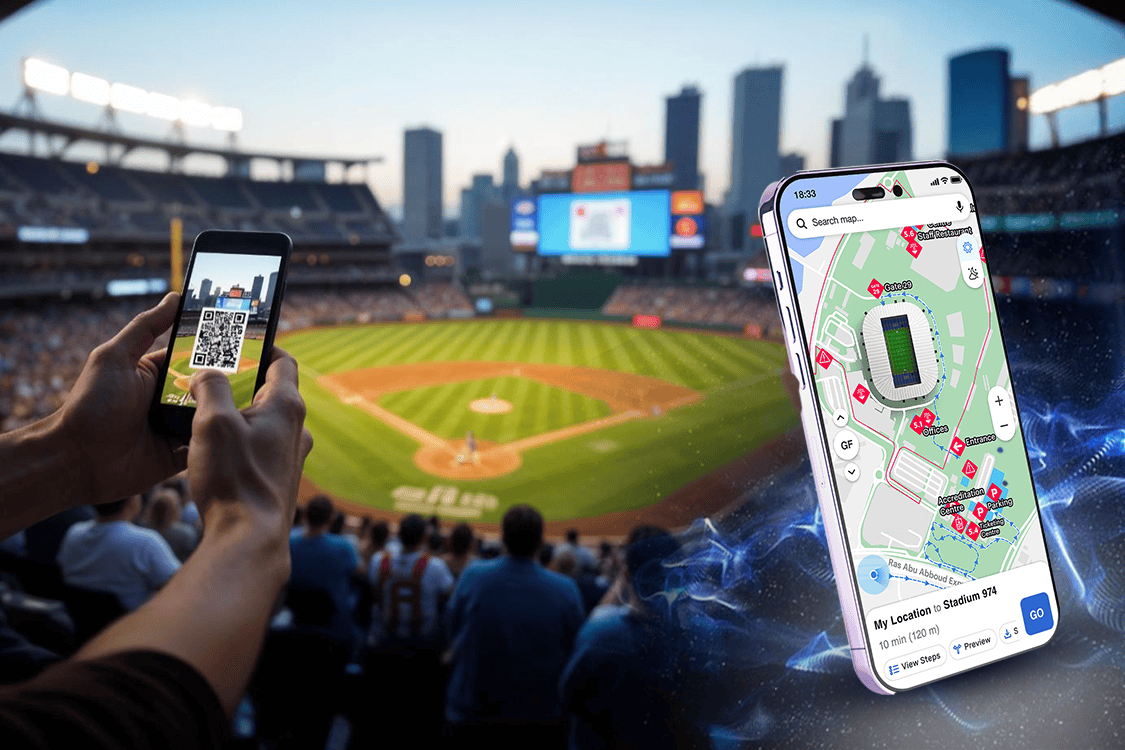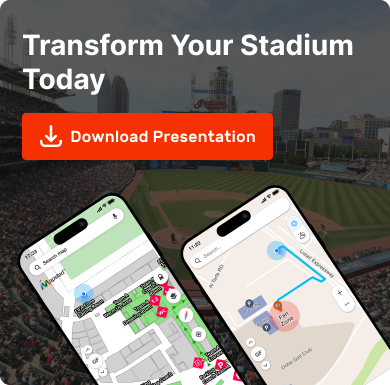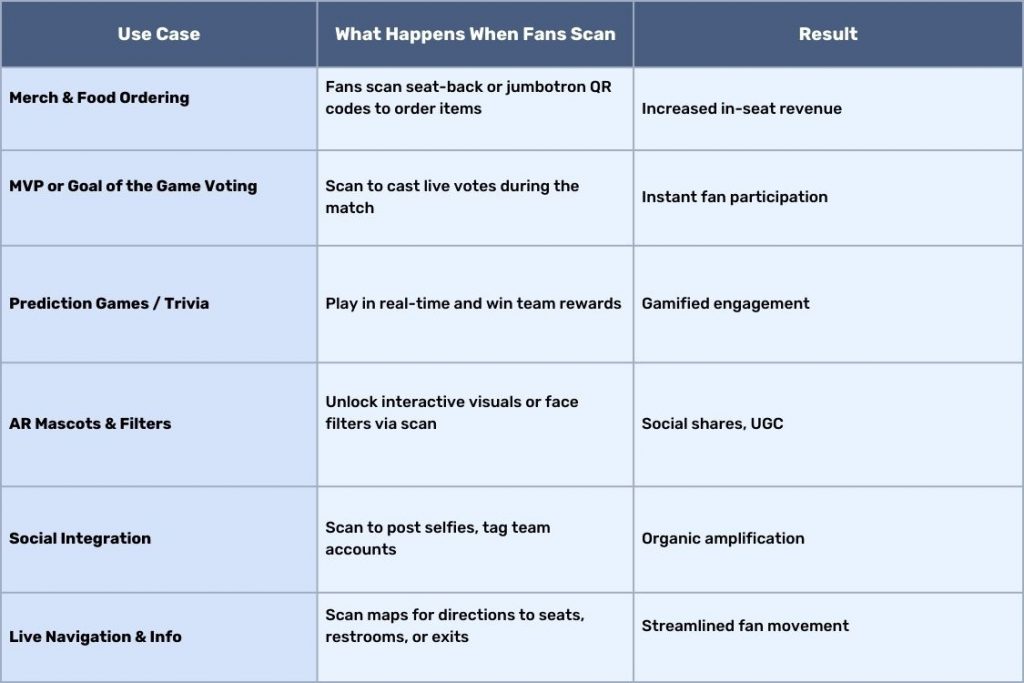Stadiums

Let’s start by answering the question: What is In-stadium QR code advertising? Suppose you are at a high-energy game, the crowd is buzzing and just as your team scores, a QR code flashes across the stadium screen with the words “Get 20% off this jersey, 5 minutes only.” One scan and fans are not just watching; they are shopping, engaging, sharing and becoming part of the brand experience.
It’s no longer just about watching the game. For marketers, QR codes are opening new ways to connect and convert in real time. As stadiums shift toward more connected, digital-first experiences, QR codes have become one of the simplest tools with the biggest impact.
Sports fans are 6–8× more engaged than the average viewer,” says Flowcode’s head of sports. No surprise then, that teams everywhere are leaning into interactive tech.
“Sports fans are 6–8× more engaged than the average viewer,” says Flowcode’s head of sports. No surprise then, that teams everywhere are leaning into interactive tech.


Let’s look at why this works so well and how some stadiums are pairing QR codes with real-time location tools to deliver smarter, smoother fan experiences.

Why QR Code Marketing Is Taking Over Stadiums
QR codes have made a massive comeback as a fundamental part of mobile-first engagement. Stadiums are the perfect place to use them, where thousands of fans can interact in real time.
Here’s why QR codes are winning:
- Frictionless access: No need to download the app, just scan and go.
- Multifunctional use cases: From voting and ordering to AR games and flash deals. For example, the Miami Heat used QR codes to let fans predict in-game plays and win prizes, turning downtime into game time.
- Real-time tracking: Marketers get instant data on who’s engaging, when and where.
- Low cost, high scalability: Unlike LED upgrades or beacon networks, QR campaigns can launch in days, not months.
Top Ways QR Codes Are Being Used Inside Stadiums:

Real-World QR Code Wins in Stadiums
These aren’t just concepts; teams and venues around the world are already using QR codes to deliver value and drive revenue:
- Vivint Arena (Utah Jazz): Fans scanned QR codes on seat armrests to order food, shop merch, or navigate the stadium, all without leaving their seats. The result? Shorter lines, smoother game-day experiences, and higher in-seat spending.
- Yankee Stadium: QR codes across the ballpark unlocked a virtual stadium tour, where fans explored team history, viewed AR trophies, and got trivia on legends, all from their phones.
- Jupiler’s Euro Cup Campaign: Limited-edition beer cans featured scannable QR codes that gave fans a chance to win jerseys or match tickets. The result was a clever retail-stadium crossover that boosted both engagement and sales.
- Philadelphia’s Lincoln Financial Field: QR codes let fans upload selfies straight to the stadium’s giant screens via the “Fan Cam”, a fun way to increase real-time UGC and social buzz.

Sports Marketing Trends 2025: QR Codes Lead the “Phygital” Shift
As stadiums embrace “phygital” (physical + digital) experiences, QR codes are becoming critical to bridging the two worlds. Fans expect personalized, real-time engagement and QR codes gives you exactly that.
Key trends shaping this shift:
- Mobile-first experiences: 82% of fans use their phones during games for more than just photos.
- Sponsorship evolution: Brands are swapping passive logos for interactive QR-led campaigns that convert in seconds.
- Zero-party data focus: Teams want first-hand data from fans and QR scans unlock names, emails, preferences and behaviour patterns instantly.
- AR + QR combos: Augmented reality triggered via QR scans is now common at NFL, La Liga and Bundesliga venues.
- Short-form attention spans: Engagement windows are tight. QR codes work in those 3-10 second windows between plays.
In fact, during the 2024 Euro Cup, over a million fans scanned QR codes for live updates, contests and merchandise rewards, proving the model works at scale.

The Real Business Benefits of QR Code Campaigns
Beyond the cool factor, what’s really driving adoption of QR code marketing in stadiums is impact you can measure.
Benefits that make stakeholders take notice:
- Boosted Conversions: QR-led offers drive immediate action from merch sales to email signups.
- Operational Efficiency: Cut down on queue time with mobile food orders or self-navigation maps.
- Better Sponsor ROI: Replace static boards with trackable scans tied to contests or coupon downloads.Actionable Analytics: See which QR codes worked, when fans scanned and what happened next.
- Real-Time Agility: Update campaigns mid-game if required, flash sales, new links, or instant content swaps.
And yes, this isn’t just for massive leagues. Even local clubs and mid-size arenas are seeing ROI from creative QR activations.
Where Mapsted Comes In
Let’s say your stadium launches QR codes across entrances and concourses. One scan opens a live map showing the fastest route to your seat or shortest concession line. But it’s not just a static link; the experience adjusts in real time.
This is where Mapsted shines.
Mapsted’s minimal hardware location technology turns stadium scans into smart journeys: no Bluetooth beacons, no external Wi-Fi. Just accurate indoor positioning powered by AI and smartphone sensors. Fans don’t just scan; they navigate, engage and convert in ways tailored to their live location. QR codes make the entry point easy. Mapsted makes the rest of the journey seamless.

Conclusion
The modern fan expects more than a seat and a hotdog. They want participation, personalization and purpose-built content that makes the live game feel like a curated digital journey.
That’s what in-stadium QR code advertising delivers when done right. It’s not about slapping a code on a banner. It’s about designing interactive, trackable, value-driven experiences that meet fans where they are both physically and emotionally.
And when you align that with smart location-based tech, real-time insights and cross-channel strategy? You don’t just get fans to scan. You get them to stay, spend and share. If you found this blog helpful, don’t miss our blog post on How Modern Stadium Designs Are Enhancing Fan Experience? or watch our video on how to Elevate the Stadium Experience With Advanced Location-Based Technology to learn more.
Frequently Asked Questions
Q1. How are QR codes being used in sports stadiums today?
Ans. Teams use them for everything from ordering food to voting on MVPs. QR codes also power interactive games, fan polls, augmented reality and real-time navigation inside the venue.
Q2. What are the biggest benefits of in-stadium QR code advertising?
Ans. Immediate fan engagement, higher in-seat spending, better sponsor ROI and valuable first-party data collection. They’re also easy to deploy and update during live events.
Q3. Can QR codes really drive revenue at live games?
Ans. Absolutely. Teams using QR-triggered offers and ordering see boosts in merchandise and concession sales. Even flash sales tied to QR codes have led to thousands in revenue within minutes.
Q4. Do fans actually scan them? Isn’t it gimmicky?
Ans. Fans love control and instant access. When QR codes offer real value like discounts or cool experiences, engagement rates can be over 15–20%, far above traditional ad click-throughs.
Q5. How can teams make the most of QR codes without tech overkill?
Ans. Keep it simple. Focus on high-traffic placements (scoreboards, seats, entrances), test compelling offers and partner with platforms like Mapsted to make the journey personalized without requiring hardware installs.

